- ON THE DECADE
- THE DECADE'S CAMPAIGN
- REPORTING ON PROGRESS
- THE DECADE'S PROGRAMMES
- FOCUS AREAS
-
- Access to sanitation
- Financing water
- Gender and water
- Human right to water
- Integrated Water Resources Management
- Transboundary waters
- Water and cities
- Water and energy
- Water and food security
- Water and sustainable development
- Water and the green economy
- Water cooperation
- Water quality
- Water scarcity
- FOCUS REGIONS
- RESOURCES FOR
- UN e-RESOURCES
'Water for Life' UN-Water Best Practices Award. 2015 edition: Finalists
Category 1
1st ranked: Cultivando Água Boa / Cultivando Agua Buena
>> More information about the initiative “Cultivando Água Boa / Cultivando Agua Buena”
2nd ranked: Renewable energy in water sanitation and hygiene in urban slums (Projects Wash-Us & News-Up), India
Background
Despite longstanding efforts, water and sanitation issues are albeit stumpy in India and urban poor are worst hit. They complement a deficient public water service at prohibitive 'coping' costs of average USD 0.67/day, or 35% of their income. Reportedly the problems of water and sanitation, responsive for 67% disease events, are vastly interlinked and also energy intensive in urban areas. Slums are located in low-lying and water-logged areas amid poor sanitary conditions and unhygienic surroundings. In this context, SAFE designed a program wherein renewable energy is the key to water and sanitation solution for the urban poor. Under the aegis of this program SAFE has launched two projects for providing safe drinking water and hygienic sanitation to marginal poor in urban slums named WASH-US (Water Sanitation and Hygiene for Urban Slums) in Kolkata and NEWS-UP (Nonconventional Energy in Water and Sanitation for Urban Poor) in north eastern India.
The project
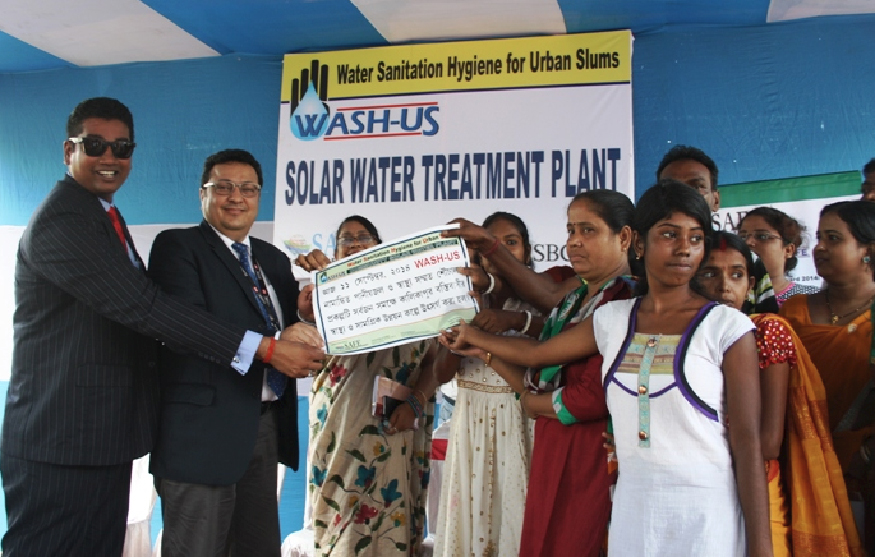
Both the WASH-US (Water Sanitation and Hygiene for Urban Slums) and NEWS-UP (Nonconventional Energy in Water and Sanitation for Urban Poor) projects provide solar powered water treatment plants which deliver 10,000 liters of drinking water complying with WHO standards on a 24X7 basis to the community through automated dispensing units. The integrated model has bio-sanitation components for providing a state-of-art sanitation facility based on microbial bio-digesters. These units are fed with wastewater enabling ‘zero’ discharge and near-zero water footprint intervention. Both projects cater to the needs of 15,000 urban poor people, improving their lifestyle and livelihoods by providing essential services, new economic opportunities and inclusive growth. The program has been supported by the World Bank and CSR funding from the HSBC Water Program.
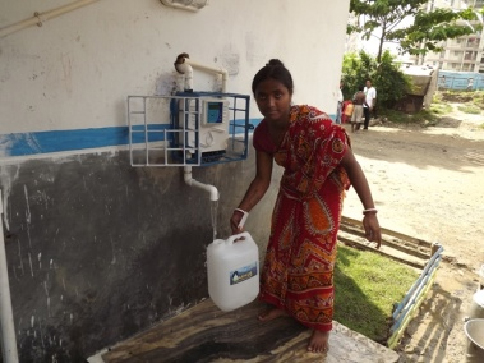
The main objective of the program was to inculcate wise-use of water resources through community governance, and recovery through water harvesting, reuse and minimization of water wastage. The program institutionalizes state-of-art community sanitation with a clean and hygienic ambience to downsize the recurrence of diseases, especially for women and children, by empowering women water users in the community. It also ensures equitable access to facilities such as Bio-sanitation and water ATMs for automated dispensing of WHO standard water round the clock for the slum dwellers through a solar run water plant. Further, it ensures social entrepreneurships through revenue linked micro-utility services in the WASH sector as an alternative economic opportunity for the poor, while displaying low carbon initiatives to downscale climate impacts and create place-based adaptive mitigation through the coupling of renewable energy to the WASH sector.
Results achieved
The impact of the projects has been measured through strategic impact assessment based quantifiable studies on sociometry, economic evaluation (Cost Benefit analysis) and ecological audit. The impact assessment was designed for Water Quality, Accessibility, Space & Time, Participation and Equity. The perception of Change and Development in the community has also been explored. The resulting outcomes are the following:
Socio-economic benefits:
- Only 17% of the total revenue earned per month is compensating the operational cost of the project.
- Better drinking water quality in terms of suspended matter, clarity, sediments offensive smell and taste.
- Easy and equitable access to water and sanitation; however 15% of the women beneficiaries apprehended problems of social dominance.
- Improved conditions and empowering for women: up to 4 hours time saving to dedicate to other activities, better sanitation and a community kitchen, which foster both privilege and pride.
- Conflict resolution on water resource allocation and access. It has empowered people with contentment over their right on the allocated volume of water from the facility.
- An effective participatory program of community governance: the Joint Liability Group members endorsed the participatory process as gender unbiased and equitable for sustainability.
- Raised motivation and demand for more technical training programs and skill development workshops.
Environmental benefits:
- Use and generation of renewable energy by the WASH-US facility.
- The 10KV Solar Water Treatment Plant and the lights in community sanitation have a carbon offset equivalence of 280 Metric Tons per year. The 4.5 Cu Mt biogas plant generates gas from human waste and municipal solid wastes and favors carbon balance by reducing landfill and fossil fuel emissions.
- Nearly 60% reduction of the water footprint thanks to the application of a conservative method based on the reuse of wastewater in the sanitation units and the capturing of 13,420 thousand gallons/year of rainwater in a 3.8 hectare water harvesting system per slum.
- Use of beneficial microbes in bio-digesters for sanitation units achieving ‘Near Zero-effluent & Near Zero emission’ status as a commendable climate connection.
3rd ranked: Water resource management for adaptation to climate change through community action in the Thar Desert, India
Background
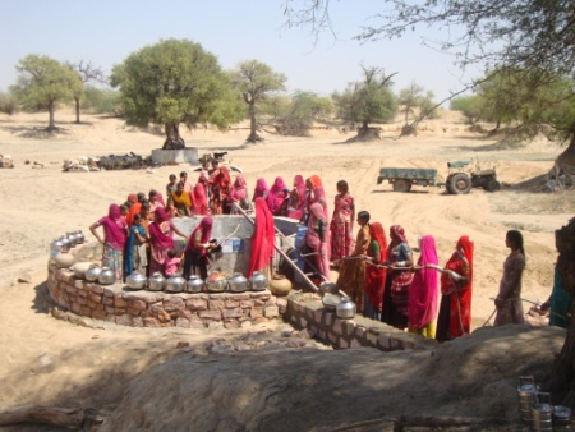
The Marwar region of the Thar Desert in Western Rajasthan, India, is the most densely populated arid zone in the world. The region has the lowest water endowment in Rajasthan, while the State itself falls in a zone of extreme water scarcity in the world (World Economic Forum report 2009). Rainfall is sparse with an annual average of 200 mm, ground water is saline and unsuitable for drinking or agriculture. Over-reliance on centralized water supply undermined wisdom developed over centuries that helped desert communities adapt to climate variability. Centralized planning pushed this traditional knowledge to the margins of development processes, with the region now facing water shortages. About 51% of the total rural habitations in the region are not covered by the government’s water supply system, 16% partially covered whereas only 33% habitations are fully covered with optimum water supply (National Habitation Survey 2003). In this context, the project addressed the challenges of reviving traditional rainwater harvesting structures that had fallen into disuse, reducing open defecation, as well as removing and regenerating encroachments on common lands, which is essential to maintain the hydrological cycle.
The project
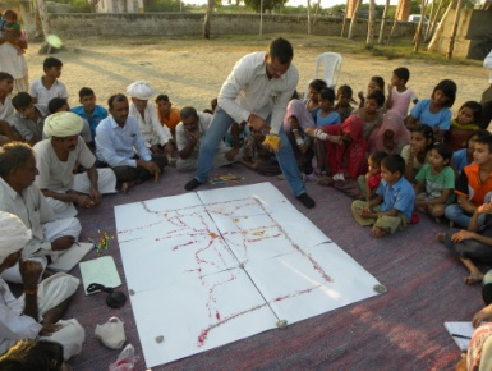
The project is supported by JBF’s HSBC and demonstrates the benefits of a cost-effective integrated model to catalyze community action on multiple components of IWRM and achieve visible, sustainable and replicable impacts on drinking water availability, sanitation, health and environmental regeneration at village level. For this purpose, four model villages were developed to showcase the positive impacts brought by the activities of the project.
The main project objectives and activities were the following:
- Development of traditional water harvesting structures like talabs (village ponds), nadis (grassland ponds) and tankas (underground water harvesting tanks) to improve access to drinking water and promote water use efficiency, as well as protection and augmentation of catchment areas of water structures like agors (catchments), orans (sacred forests) and gauchars (grasslands).
- Design and implementation of a drainage system in one pilot village to showcase the benefits of improved drainage at village scale.
- Facilitation and capacitation of Jal Sabhas (water user associations) in the project villages to implement a water, land and sanitation program integrating concerns of women and disadvantaged communities. These include the implementation and maintenance of four water harvesting and conservation system for improved water capacity, household level support for tankas (underground water harvesting tanks) and toilets.
- Establishment of Norms for adaptive water and pasture management and participation of women and disadvantaged communities in the community institution.
The project applies a three-pronged approach to sanitation by using the village-level fund into which groups of 10 individual households make a 50% contribution upfront to gain financial support of the remaining 50% from JBF. Such an approach embeds individual efforts within a group that offers mutual support and motivation, while using the community level forum to provide additional motivation, support and ensure transparency and accountability in the use of funds.
Results achieved
- The project demonstrates a replicable catalytic social engagement and challenge based financing approach that results in cost-effective local solutions to water scarcity, inclusive community institutions, ownership and sustainability through a 30% local contributions for IWRM infrastructure.
- The project has developed the full matrix of traditional water harvesting structures like talabs (village ponds), nadis (grassland ponds) and tankas (underground water harvesting tanks) to create a ‘community led climate resilient water management system’ through participatory approaches, traditional knowledge and financial contributions from Potaliya’s community. The protection and augmentation of catchment areas of water structures like agors (catchments), orans (sacred forests) and gauchars (grasslands), that are the repositories of biodiversity, have improved the efficiency of water harvesting structures even during scant rainfall, thereby adapting to climate change.
- As a result of the project’s three-pronged approach, village-level sanitation coverage has increased from baselines between 6-25 % to almost 50- 70%.
- The increase of water availability, reduction of dependence on expensive and unsafe water from tankers and the removal of individual encroachments on village land to augment them through indigenous fodder grass and mixed plantations has disproportionately benefited the poorest sections of the community that are most dependent on common property resources.
- The successful cooperation with local government ensures time-bound convergence and cooperation within the project supported overall IWRM planning. The project’s model approach is being formalized through a MoU going beyond existing formats for cooperation with local government and inspired by JBF’s experiment with a ‘Development Pact’. The community-local government-JBF cooperation ‘Pact’ has the potential for replication within the existing Government water policy and budget.
- The project has pioneered the adaptation of a new water recharge technology from Africa, replicating it at lower cost and by combining it with traditional check-dam know-how. The village of Potaliya is also the first village to pioneer a village co- financed drainage system in Rajasthan addressing challenges of rain variability and vector-borne diseases.
Category 2
1st ranked: Social arts for community mobilization and safe water access – Project India
1st ranked: South African DWS / WESSA Eco-Schools Water Project
>> More information about the initiative “South African DWS / WESSA Eco-Schools Water Project”
2nd ranked: Resource-Oriented Sanitation concepts for peri-urban areas in Africa (ROSA)
Background
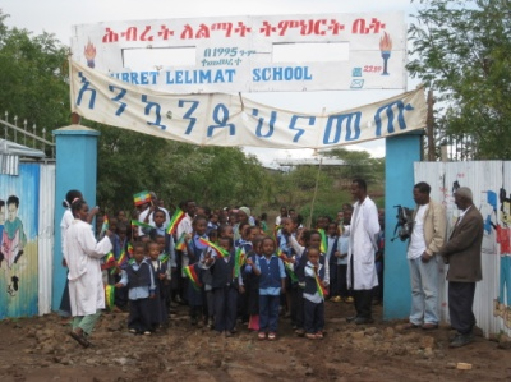
The project has promoted resource-oriented or ecological sanitation concepts as a route to sustainable sanitation in Africa. To achieve this objective it developed and introduced integrated low cost technologies for sustainable sanitation, as well as community-based management concepts. These concepts were applied in four cities in East-Africa, namely Arba Minch (Ethiopia), Nakuru (Kenya), Arusha (Tanzania) and Kitgum (Uganda). Several types of toilets that allow reuse have been constructed in private houses, institutions and schools. Also, the project developed Strategic Sanitation and Waste Plans (SSWPs) for the four pilot cities in order to initiate a process of integration of such aspects in the towns' agendas. These provided examples for a generally applicable and adaptable framework for the development of participatory strategic sanitation.
The project
The overall objectives of the ROSA project were:
- to promote resource-oriented sanitation concepts as a route to sustainable sanitation and to fulfill the UN MDGs;
- to implement resource-oriented sanitation concepts in four model cities in East Africa;
- to research the gaps for the implementation of resource-oriented sanitation concepts in peri-urban areas, and;
- develop a generally applicable adaptable framework for the development of strategic sanitation & waste plans (SSWPs).
The project started in October 2006 and ended in March 2010. The consortium comprised 13 partners from Europe and Africa. Main features included the following:
- The participation of municipalities in the project consortium as an important step towards sustainable implementation of sanitation concepts.
- ROSA was the first project in this field where the municipalities work with their local universities.
- The municipality and the university formed the core of a wider local network in which ROSA invited authorities, NGOs, CBOs, etc. working in the field sanitation to participate.
- Research in ROSA was demand driven and defined by the local African partners.
Results achieved
In general the research activities within ROSA contributed to improving the competitiveness of resource-oriented sanitation concepts in peri-urban areas. Institutional-organizational innovations resulted from operation and management strategy development. Technical innovation was associated to the solutions implemented in the project, as well as from the integration of the resource-oriented sanitation concepts into local settlement structures. Finally financial-economic matters were tackled analyzing in details costs associated to the construction and installation of the identified solutions, as well as operation and maintenance costs.
At the end of the projects the pilots were in operation in all cities. Most implemented solutions have been successfully adopted by the local communities. Beneficiaries spread information of the new options to other areas. As a result private persons as well as organizations got interested and built sanitation systems with their own resources (ROSA provided technical support only). Awareness regarding the need of operation and maintenance was created in all pilot cities. Large-scale implementation of on-site sanitation was launched in Arba Minch and Nakuru.
>> FAQs
>> Statutes
>> Categories
>> Chinese![]()
>> English![]()
>> French![]()
>> Spanish![]()
>> By numbers
>> Candidates
>> Evaluation committee
>> Selection committee
>> Finalists
>> Winners
>> Ceremony
>> By numbers
>> Candidates
>> Evaluation committee
>> Selection committee
>> Finalists
>> Winners
>> Ceremony
>> By numbers
>> Candidates
>> Evaluation committee
>> Selection committee
>> Finalists
>> Winners
>> Ceremony
>> By numbers
>> Candidates
>> Evaluation committee
>> Selection committee
>> Finalists
>> Winners
>> Ceremony
>> By numbers
>> Evaluation committee
>> Selection committee
>> Candidates
>> Finalists
>> Winners
>> Ceremony
Copyright | Terms of use | Privacy notice | Site Index | Fraud alert | Help





